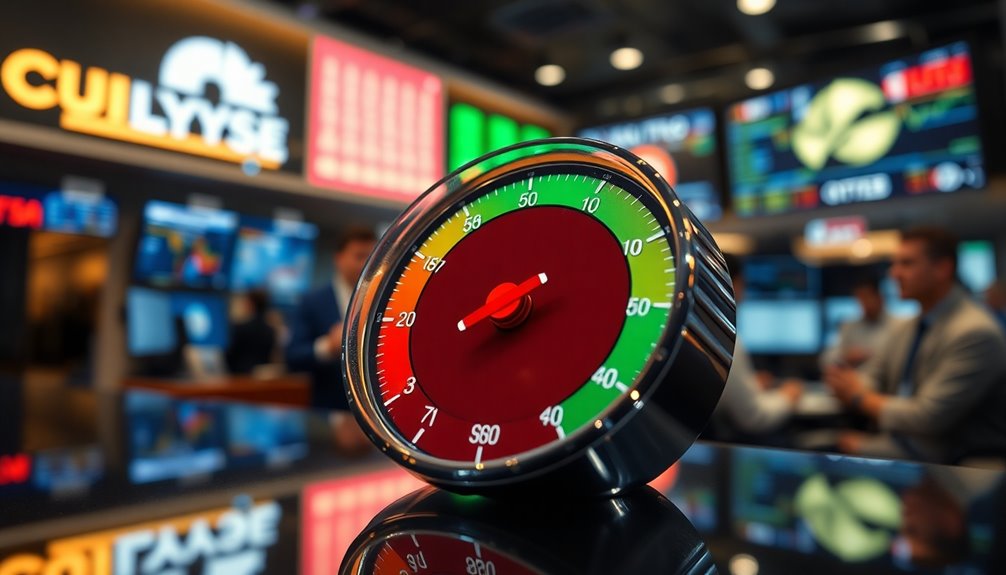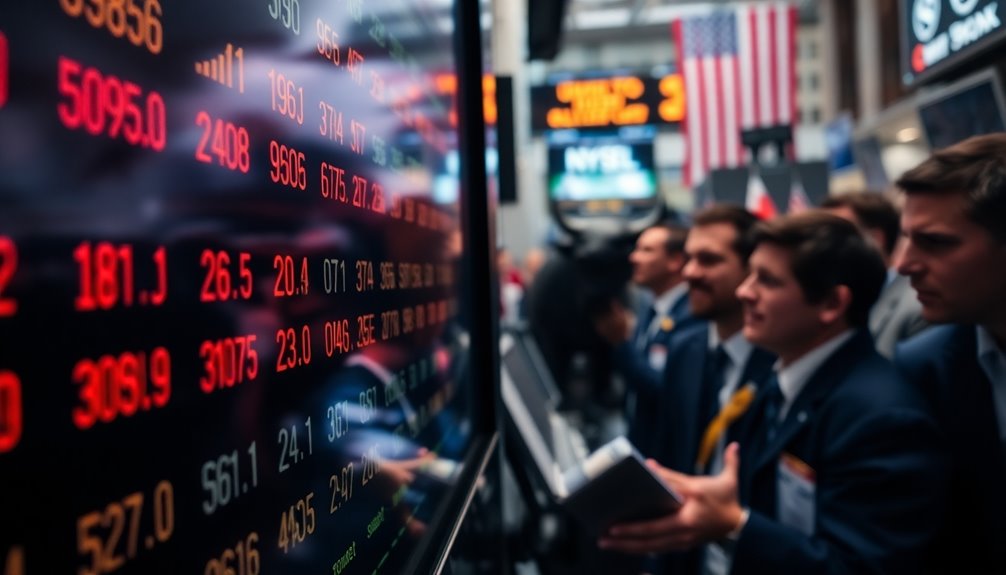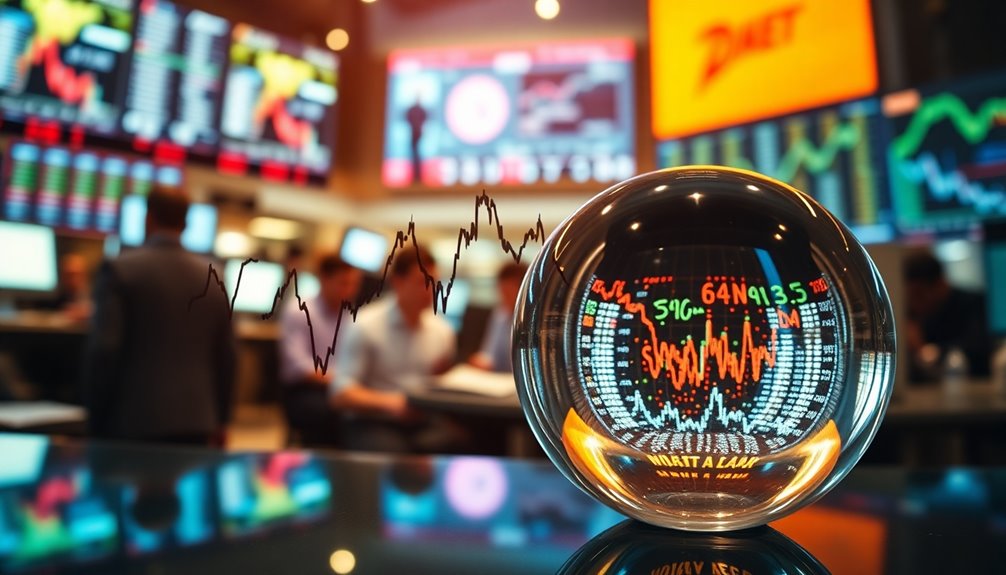The Fear and Greed Index is a valuable tool that helps you gauge market sentiment. Developed by CNN Business, it measures emotions in the market, scoring from 0 (Extreme Fear) to 100 (Extreme Greed). It uses seven indicators, such as stock price momentum and market volatility, to calculate its score. When the score is between 0-30, fear dominates; a score of 71-100 indicates greed. Understanding this index can help you identify potential buying opportunities and market trends, enhancing your investment strategy. Curious about how it works and its implications on your investments? There's more to uncover.
Key Takeaways
- The Fear and Greed Index measures market sentiment on a scale from 0 (Extreme Fear) to 100 (Extreme Greed).
- Developed by CNN Business, it utilizes seven indicators to gauge investor psychology and market trends.
- Scores between 0-30 indicate extreme fear, while scores of 71-100 reflect extreme greed in the market.
- The index helps identify potential buying opportunities during extreme fear and cautions against overvaluation during extreme greed.
- It should be used alongside other market analysis tools for a comprehensive understanding of market dynamics.
Market Sentiment Gauge

The Fear and Greed Index serves as a vital tool for understanding market sentiment. Developed by CNN Business, it gauges investors' emotions using seven standardized indicators. Ranging from 0 (Extreme Fear) to 100 (Extreme Greed), this index captures market volatility, stock price momentum, and demand for safe-haven assets, with each factor contributing equally to the overall score. The index is calculated using seven market indicators, which provides a comprehensive view of investor behavior.
When the index falls between 0-30, it signals extreme fear, often pointing to undervalued assets. Conversely, a score of 71-100 indicates extreme greed, which can suggest overvaluation.
Understanding Market Emotions

Understanding market emotions is key to making informed investment decisions. The Fear and Greed Index reveals how extreme fear can lead to undervalued assets, while extreme greed can inflate prices.
Your investment strategies can benefit significantly by observing these emotional shifts. For instance, during times of extreme greed, you might consider reducing your investments or exiting positions, whereas extreme fear could prompt you to seek undervalued stocks. This index serves as an emotional barometer, helping you gauge market sentiment rather than long-term trends. However, use it cautiously; combine it with other indicators to achieve a more comprehensive understanding. The index aims to help investors manage emotions effectively and make informed decisions.
Index Calculation Methodology

While investors often rely on various metrics to assess market conditions, the calculation methodology behind the Fear and Greed Index is crucial for interpreting its results.
The Index is based on seven indicators, including the performance of the S&P 500 against its 125-day moving average and the ratio of stocks hitting 52-week highs versus lows on the NYSE. Each factor is scored from 0 to 100 and equally weighted, resulting in a final value between 0 and 100.
High scores indicate greed, suggesting optimism among investors, while low scores signify fear, potentially pointing to undervalued stocks. This balanced approach ensures no single indicator dominates, providing a comprehensive view of market sentiment. Additionally, the index utilizes multiple factors such as market volatility and safe haven demand to gauge overall investor sentiment.
Pros and Cons

Investors often find value in the Fear and Greed Index, but it's important to weigh both its advantages and disadvantages.
On the plus side, the index helps you identify buying opportunities during extreme fear, signaling potential market rebounds. It reflects market sentiment, serving as an emotional barometer that complements other analyses. Additionally, it aids in risk management by highlighting overbought or oversold conditions, enhancing your market timing. The index is derived from seven indicators that measure various aspects of market sentiment and volatility, providing a more nuanced view of investor behavior.
However, its short-term focus can misrepresent long-term trends. Irrational market sentiment may lead to sudden shifts, making it unreliable as a sole decision-making tool.
Therefore, it's best used alongside other indicators for a more comprehensive view of market behavior.
Fear vs. Greed Dynamics

Fear and greed are powerful forces that shape market dynamics, often driving investors to make impulsive decisions.
When fear dominates, you might see low scores on the Fear and Greed Index, leading to asset sell-offs and plummeting prices. In such times, you may gravitate towards safer investments, like money-market securities. This reaction can be explained by the index's measurement of market sentiment, which often influences asset pricing during periods of extreme fear. Historical performance of similar coins can also provide insights during these fearful market conditions.
Conversely, when greed prevails, high index scores can inflate asset prices, causing many to overlook inherent risks. During these bullish periods, the urge to buy can lead to overvaluation. Recognizing these emotional influences is crucial for your investment strategy. By understanding fear and greed dynamics, you can adopt a contrarian approach, seizing opportunities to buy low during fear or sell high during greed, ultimately enhancing your market position.
Market Volatility Impact

Market volatility significantly influences investor sentiment and decision-making. When market volatility rises, it often signals fear, reflected in higher VIX values, which can lead you to become more cautious. Conversely, lower volatility tends to indicate a sense of greed, prompting more bullish behavior among investors. Recognizing these trends helps you navigate market conditions effectively. For instance, during periods of extreme volatility, like those seen in late 2022, you might feel compelled to adjust your investment strategy. By staying aware of market volatility's impact, you can avoid emotional biases and make informed decisions. Additionally, the correlation between the Fear & Greed Index and the VIX highlights how changes in market sentiment can affect investor behavior. Ultimately, understanding how volatility intertwines with the Fear & Greed Index equips you to anticipate market movements and refine your investment approach.
Recent Index Fluctuation Patterns

While the Fear and Greed Index can fluctuate rapidly, recent patterns have revealed shifting sentiments in both traditional and crypto markets.
In traditional markets, a high index score indicates extreme greed, with 95% of investments in stocks and only 5% in cash. This suggests that investors are feeling optimistic, though it may hint at overpriced stocks. Historically, a higher score reflects increased investor confidence and provides insights into the potential for market volatility.
Conversely, in crypto markets, extreme fear often signals potential buying opportunities, while extreme greed can indicate a correction is near.
Both markets reflect emotional influences on pricing, with rapid sentiment changes often driven by market momentum and news.
Monitoring these patterns helps you gauge when to adjust your portfolio for better alignment with market conditions.
Monitor News Headlines Regularly

Shifts in investor sentiment can be swift and unpredictable, making it vital to keep a close eye on news headlines. Headlines can sway emotions, driving fear or greed, which impacts stock prices directly. Positive news often boosts prices, while bad news can trigger selloffs. With the 24-hour news cycle, you might find yourself reacting to news quickly, sometimes leading to overreactions and market mispricings. By monitoring these headlines, you can better gauge market sentiment and adjust your investment strategies accordingly. This approach also aids in risk management, allowing you to identify potential opportunities or risks. Moreover, AI-driven data analytics can help in tracking these trends and understanding the underlying factors influencing market movements. Ultimately, integrating news analysis with the Fear and Greed Index gives you a more comprehensive understanding of market conditions and investor behavior. Furthermore, keeping an eye on the volatility index (VIX) can provide additional insights into investor fear levels.
Frequently Asked Questions
How Often Is the Fear and Greed Index Updated?
The Fear and Greed Index updates regularly to mirror current market conditions.
While there's no exact schedule, it can refresh daily or even more frequently during times of high volatility.
For instance, the Crypto Fear and Greed Index updates every 12 hours.
You'll find that various financial platforms provide real-time access, allowing you to stay informed about market sentiment as it shifts throughout the trading day.
Can Individual Investors Use the Fear and Greed Index Effectively?
Yes, you can use the Fear and Greed Index effectively as an individual investor.
By monitoring sentiment, you can identify potential buying or selling opportunities. When the index shows extreme fear, it might signal a good time to buy, while extreme greed could indicate it's time to sell.
Just remember to combine it with other analysis tools and consult a financial advisor to tailor strategies to your specific risk tolerance and investment goals.
What Assets Does the Index Primarily Focus On?
Picture yourself navigating a bustling marketplace, where prices fluctuate wildly based on emotions. The index primarily focuses on stocks within the S&P 500, capturing the heartbeat of major U.S. companies.
It also considers options trading and alternative assets like gold and bonds, reflecting investor sentiment. By tracking these assets, you can gauge when the market's feeling greedy or fearful, helping you make smarter investment choices amidst the market's chaos.
Are There Historical Trends Associated With the Fear and Greed Index?
Yes, there're notable historical trends associated with the Fear and Greed Index.
You can observe that extreme fear often indicates a potential buying opportunity, while extreme greed suggests overvalued markets.
For instance, during crises, like the 2008 financial downturn, the index dropped sharply, signaling a chance to buy.
Conversely, after significant market rallies, high greed levels emerged, hinting at potential corrections.
How Do Psychological Factors Influence the Index Readings?
Just like Icarus flying too close to the sun, your emotional responses to fear and greed can lead to costly mistakes in investing.
When fear grips the market, it prompts you to sell hastily, while greed can lure you into risky investments. These psychological factors skew your judgment, causing volatility.
Recognizing these emotions helps you navigate the market more rationally, allowing you to make informed decisions rather than succumbing to panic or overconfidence.
Conclusion
In conclusion, the Fear and Greed Index serves as a valuable tool for gauging market sentiment and guiding your investment decisions. Did you know that historically, extreme fear often signals a buying opportunity, with the market rising an average of 25% in the following year? By keeping an eye on this index and understanding the emotions behind it, you can better navigate market volatility and make more informed choices for your portfolio.









